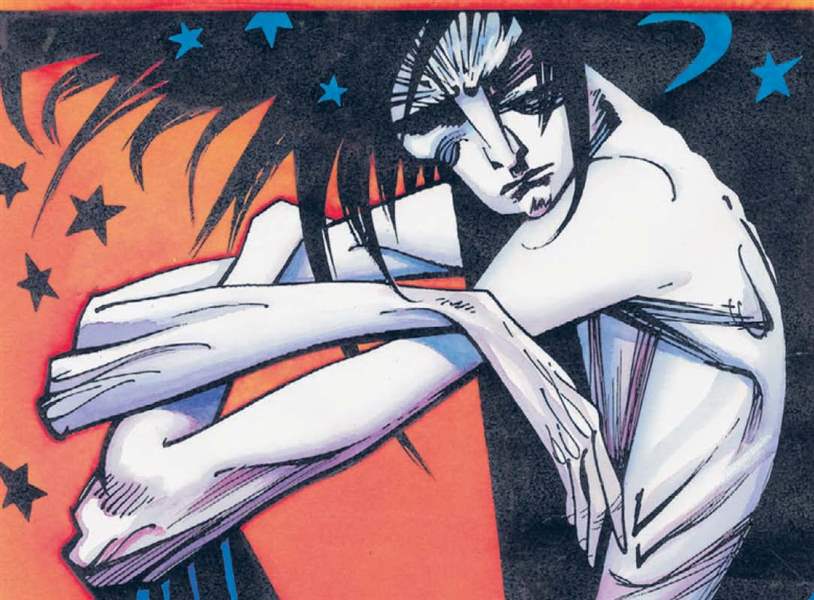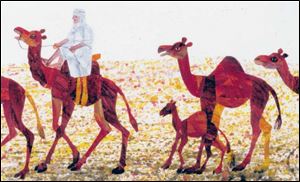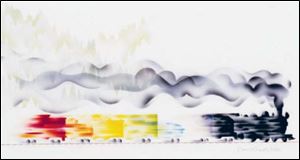
The word on art: Toledo museum presents a trio of shows that appeal to all ages
10/25/2009
‘The Sandman,' by Marc Hempel, in LitGraphic.

‘The Sandman,' by Marc Hempel, in LitGraphic.
Words play nice with images in three shows that continue into the new year at the Toledo Museum of Art.
LitGraphic: The World of the Graphic Novel is the largest in the spacious Canaday Gallery, with 150 pieces by two dozen artists spanning nearly a century. Many are current illustrators, such as Peter Kuper (he does SPY vs SPY for Mad magazine and cofounded World War III Illustrated), and Marc Hempel (Breathtaker and The Sandman). Lauren Weinstein is one of the few women represented with Girl Stories, zany semi-autobiographical tales of teen years.
There's work by Harvey Kurtzman, founding editor of Mad, and R. Crumb, who created the Keep on Truckin', Fritz the Cat, and Mr. Natural comics, the album cover for Cheap Thrills, and the controversial new Book of Genesis.
Will Eisner, a pioneer in the adult comic genre, coined the term "sequential art." He spent two years creating four short stories set in 1930s Bronx tenements called A Contract with God, published in 1978.
There are copies of Marvel comics' Strange Tales by Stan Lee and Steve Ditko with wonderfully lurid titles such as The Bouncing Ball of Doom! and To Free a Brain Slave. And a video loop showing interviews with several illustrators plays on a couple of screens.

Camels,' from ‘Animals Animals,' by Eric Carle, in Storybook Stars.
Usually considered a younger, adolescent sibling of fine art, cartooning is a hot niche of contemporary art, steadily growing a generation of fans and commanding substantial space in bookstores. In recent years, museums and galleries around the world have reached out to younger visitors with comics shows. This traveling exhibit was assembled by the Norman Rockwell Museum in Massachusetts and rented by the Toledo museum.
Word Play
Next to the Canaday Gallery is the snug Gallery 18, filled with 30 provocative pieces, each presenting an idea about how language alters the way in which we perceive an image.
"A lot of it is about suggesting imagery to your brain," says Amy Gilman, who pulled together Word Play from the museum's collection. These artists aim to evoke an image, via language, that's in addition to the visual piece.
"I really wanted to show that artworks that rely on language are not boring and dry. They're colorful, they're dynamic, they're playful," says Gilman, associate curator of contemporary art.
The show's inspiration was John Giorno's Welcoming the Flowers, a wall-sized recent acquisition of 18 framed prints, each 16 inches square. For more than 40 years, Giorno (the sleeping subject in Andy Warhol's five-hour film, Sleep) has been linking poetry with other media. In 1968, he created Dial-A-Poem.
Each of Giorno's colorful prints is a tiny poem in upper-case letters: "LILACS LUXURIOUSLY LICKING THE AIR," "NECKLACES OF WISTERIA BOWING TO MAGNOLIA MAMAS," and "ORCHIDS ARE THE TONGUES THAT LIED."

‘Moving Through Forests' from ‘Freight Train,' by Donald Crews, in Storybook Stars.
Without their colorful and substantial visual presentation, these poetic fragments wouldn't amount to much.
In another grouping, each of nine prints by Barbara Kruger features a magazine-style photo of a different person and a single word. Find the words and read them as a complete sentence.
In a piece by Werner Pfeiffer, words of different colors, sizes, and fonts are spread to make a series of circles and cutouts.
A large frame holds three rows of 21 pages of The Autobiography of Malcolm X, across which are spread a thick, black M and X. It's the result of a teacher's efforts to engage his at-risk students with literature that might otherwise intimidate them.
In his stand-up book, Thomas C. Ely has drawn shapes and symbols we recognize as language and explanatory diagrams, but that are thoroughly cryptic.
Lining the downstairs corridors that lead to the Peristyle are 75 award-winning illustrations from children's books of the last 50 years. Most are preliminary pencil sketches the artists made as they began fleshing out character and story line.
Storybook Stars: Award-Winning Illustrations from the Mazza Collection presents the process of creating art for books, a variety of techniques and styles, and a cultural range of stories.
Note six sketches near the front by Anita Lobel: the grouping starts with a paper swirled with quick lines and ends with an intricate watercolor/pen-and-ink illustrating the letter "K" in a page from her 1981 On Market Street.
Among other heavyweights represented here are Maurice Sendak, Eric Carle, Arnold Lobel, and Theodore Geisel (aka Dr. Seuss).
The show is geared toward grown-ups, but children will like related books on racks they can reach and a couple of wooden benches.
At a time when museum finances are pinched, this show is a smart collaboration with a fine nearby institution, the Mazza Collection at the University of Findlay. Founded in 1982 with four pieces of art, the Mazza has grown to have 3,000 original works from children's literature and a freestanding museum that offers speakers and classes.
Contact Tahree Lane at:
tlane@theblade.com
or 419-724-6075.